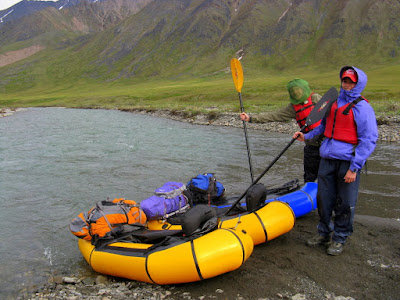
I looked back over my shoulder and they were still there. Completely lost in their thoughts and undoubtedly struggling to deal with the miserable situation. I began to seriously question my decision to bring two 15-year old kids on this trip. We had been stumbling across knee deep tussocks in the late afternoon heat fully draped in our armor of raingear for hours. The uneven surface made it nearly impossible to move in any direction. Each erratic and unstable step ended with a sharp roll of the ankle as we clumsily navigated through the maze of towering tufts of grass. But we had to keep progressing forward because the incessant humming of the mosquito filled atmosphere was maddening. The continuous ricochet of bugs against our bodies felt like a torrential shower of raindrops pelting our clothing. There was no choice but to move on to a place where the ground would firm up enough to allow us to setup camp and take refuge in our tent.
I knew better than to head to the Arctic this late in June but I thought we had a few more days of reprieve before the onset of bugs. We were a day too late. The season is short this far north and the tundra explodes with new life every hour during the start of the brief warm season and 24-hour sunshine. My nephew Mark and his friend Mara were up for the adventure and decided it was worth the gamble. So we spent summer solstice above the Arctic Circle in the shadow of spectacular folded limestone cliffs, fields of wildflowers, diving raptors, howling wolves, following the footprints of grizzly bears, and sacrificing ourselves to the hordes of blood thirsty mosquitoes.














Thursday, June 25, 2009
Kids on the Itkillik
Posted by
Ed Plumb
at
12:07 PM
![]()
Labels: Packrafting
Subscribe to:
Post Comments (Atom)


2 comments:
Awesome trip write-up Ed. And the mosquito video is absolutely crazy.
J.
Really enjoy your pics and trips, more more more!!!
Post a Comment